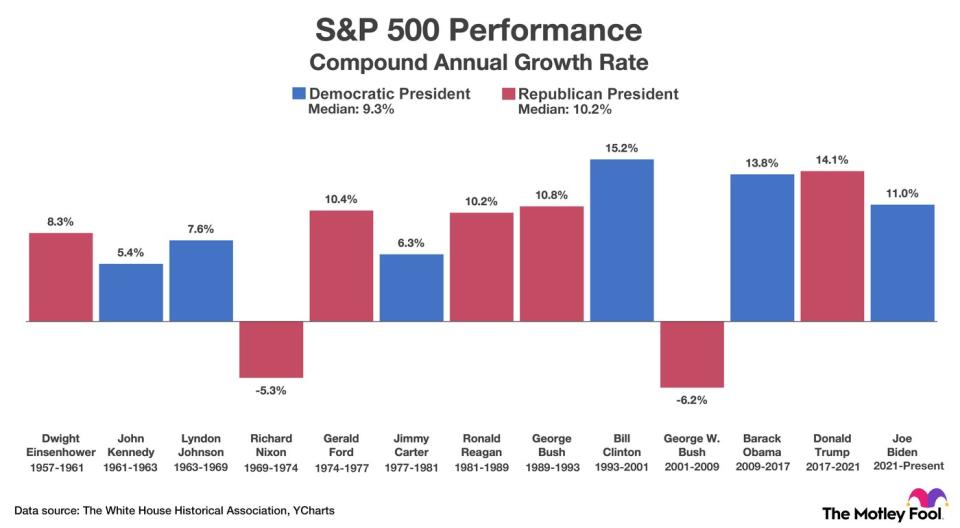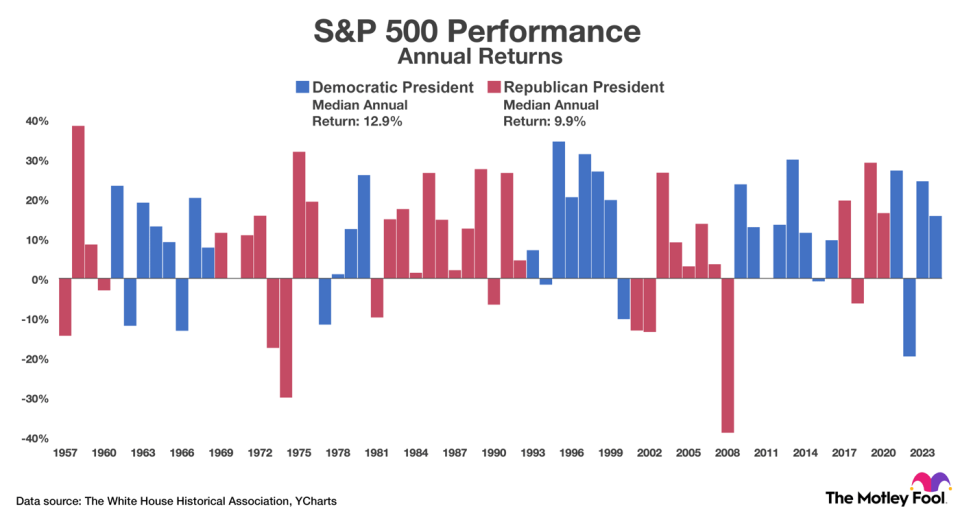Here's the Average Stock Market Return Under Democratic and Republican Presidents (Hint: It May Surprise You)
The S&P 500 (SNPINDEX: ^GSPC) is widely regarded as the best barometer for the overall U.S. stock market due to its scope and diversity. The index tracks 500 large American companies that span all 11 market sectors, covering about 80% of domestic equities by market capitalization.
The S&P 500 has returned 43%, or 11% annually, since Joe Biden was inaugurated as the 46th U.S. president on January 20, 2021. But with the next presidential election just months away, investors may be curious about how the stock market has performed under other Democratic and Republican presidents.
The average stock market return under Democratic and Republican presidents
The S&P 500 was created in March 1957. Since its inception, the index has returned 12,510% excluding dividend payments, which is equivalent to a compound annual growth rate (CAGR) of 7.4%. That does not mean the S&P 500 has increased 7.4% in every year, but rather that it has returned an average of 7.4% annually since 1957.
The graphic below shows the S&P 500's CAGR during each presidency. It also shows the median CAGR under individual Democratic and Republican presidents. Dividend payments are excluded.

Since 1957, the S&P 500 has achieved a median CAGR of 9.3% under Democratic presidents and 10.2% under Republican presidents. Based on that information, it would be logical to conclude that the stock market has performed better when Republicans control the White House.
Not so fast! Statistics are easy to manipulate. Let's consider the question from another perspective. The graphic below shows the S&P 500's return in each individual year since 1957. It also shows the median one-year return under Democratic and Republic presidents. Dividend payments are excluded.

Since 1957, the S&P 500 has achieved a median one-year return of 12.9% under Democratic presidents and a median one-year return of 9.9% under Republican presidents. Based on that information, it would be logical to conclude that the stock market has performed better when Democrats control the White House.
So, which political party is best for the stock market? It depends on how the data is analyzed. The S&P 500 has seen good years and bad years under Democrats and Republicans. However, the question itself is ultimately irrelevant for two reasons. First, macroeconomic fundamentals (not political parties) control the stock market. Admittedly, presidential policy and congressional legislation impact the economy, sometimes significantly, but no single person or political party ever has complete control.
Second, selectively buying and selling stocks based on which political party controls the White House is a bad strategy that has historically led to underperformance. Research from Goldman Sachs shows that "investing in the S&P 500 only during Republican or Democratic presidencies would have resulted in major shortfalls versus investing in the index regardless of the political party in power."
Historically, the stock market has made patient investors richer regardless of politics
With the 2024 election fast approaching, both presidential candidates may claim to be better for the stock market. They may even back their claims with data. But investors should ignore such comments. Statistics can be manipulated to fit different agendas, and stock prices are governed by macroeconomic factors beyond the control of any political party.
To illustrate my point, consider the dot-com bubble, the Great Recession, and the Covid-19 pandemic. All three events led to stock market crashes, none of which could have been avoided by the president in power at the time. The Democrats cannot be praised for inflated valuations across the technology sector during the mid-1990s, nor can Republicans be blamed for holding office when years of lax lending standards culminated in the financial crisis in 2008.
More importantly, history says patient investors will be well rewarded regardless of which political party controls the White House. The S&P 500 returned 2,080% over the last three decades including dividends, which is equivalent to 10.8% annually. That period encompasses such a broad range of economic climates that investors can be reasonably confident in similar returns in the future.
That does not mean the S&P 500 will return 10.8% every year, but rather that the index will return approximately 10.8% annually (give or take a percentage point) over the next several decades.
Should you invest $1,000 in S&P 500 Index right now?
Before you buy stock in S&P 500 Index, consider this:
The Motley Fool Stock Advisor analyst team just identified what they believe are the 10 best stocks for investors to buy now… and S&P 500 Index wasn’t one of them. The 10 stocks that made the cut could produce monster returns in the coming years.
Consider when Nvidia made this list on April 15, 2005... if you invested $1,000 at the time of our recommendation, you’d have $786,046!*
Stock Advisor provides investors with an easy-to-follow blueprint for success, including guidance on building a portfolio, regular updates from analysts, and two new stock picks each month. The Stock Advisor service has more than quadrupled the return of S&P 500 since 2002*.
*Stock Advisor returns as of July 2, 2024
Trevor Jennewine has no position in any of the stocks mentioned. The Motley Fool has positions in and recommends Goldman Sachs Group. The Motley Fool has a disclosure policy.
Here's the Average Stock Market Return Under Democratic and Republican Presidents (Hint: It May Surprise You) was originally published by The Motley Fool
